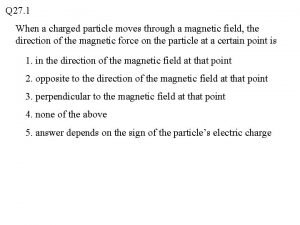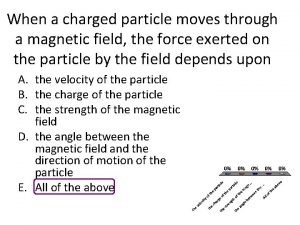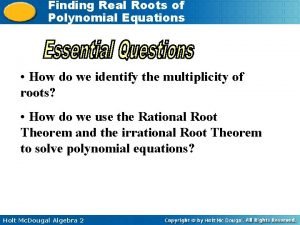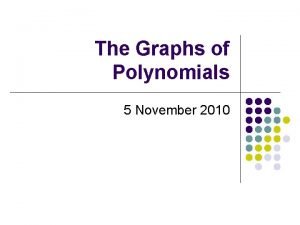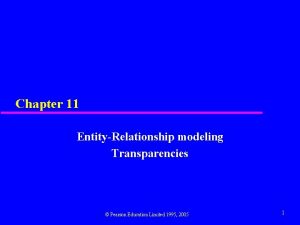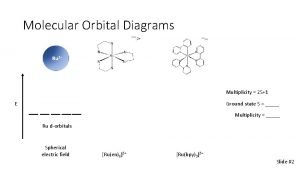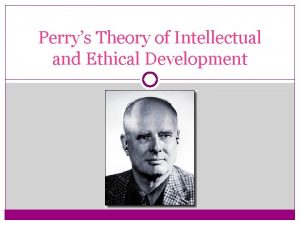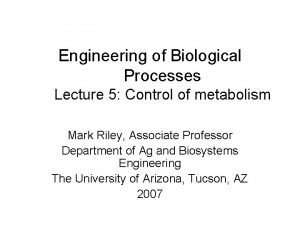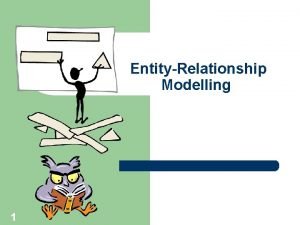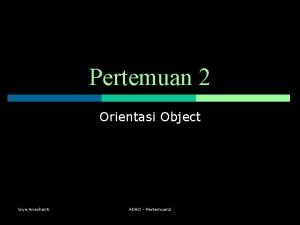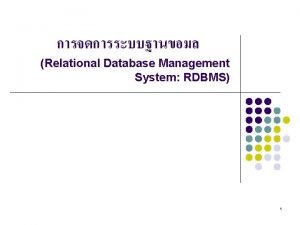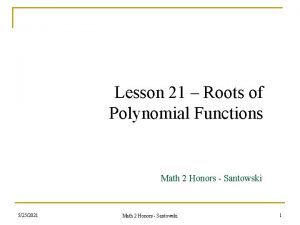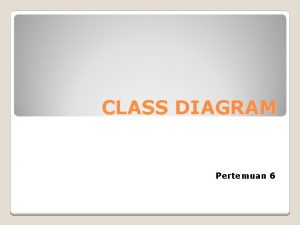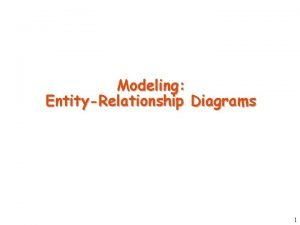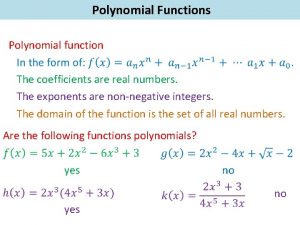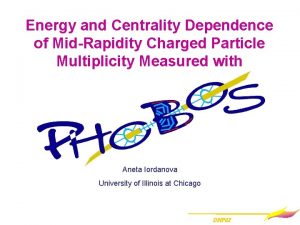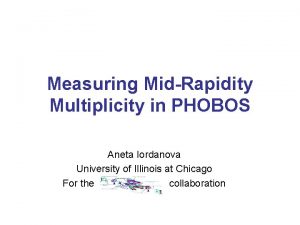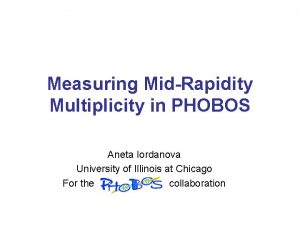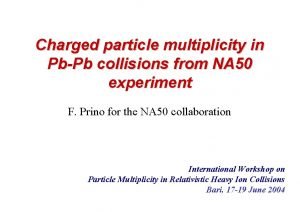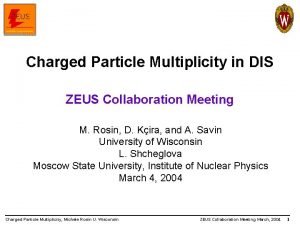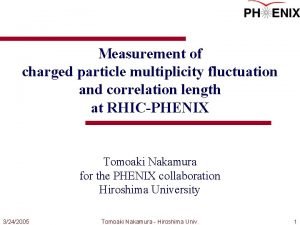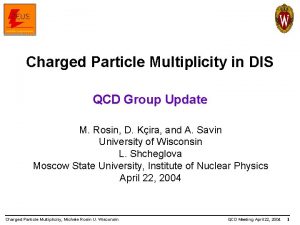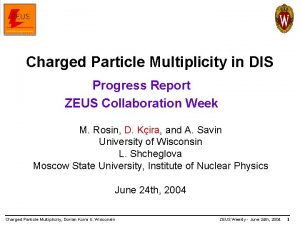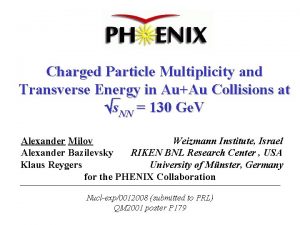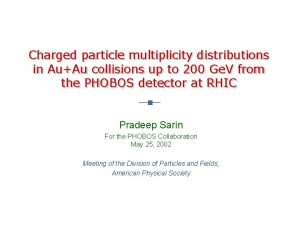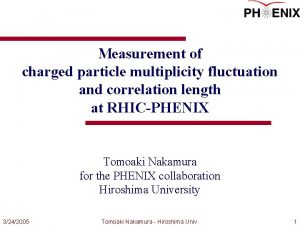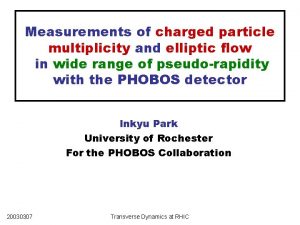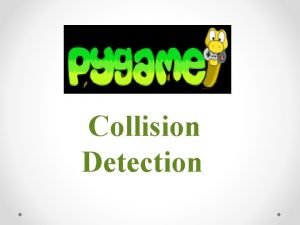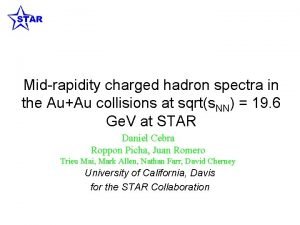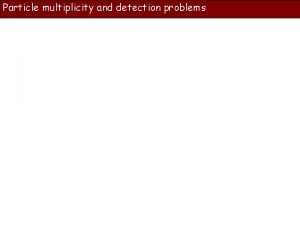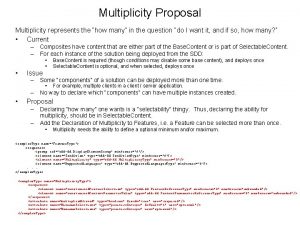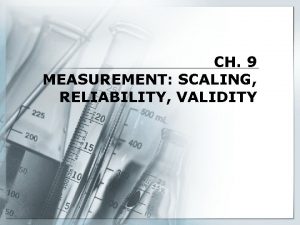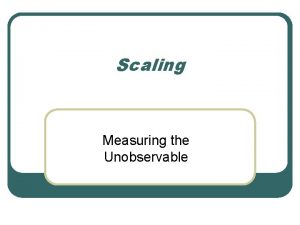Collision Geometry Scaling of MidRapidity Charged Particle Multiplicity






















- Slides: 22

Collision Geometry Scaling of Mid-Rapidity Charged Particle Multiplicity in PHOBOS from √s. NN = 19. 6 to 200 Ge. V Aneta Iordanova University of Illinois at Chicago For the collaboration DNP 04/Chicago

Outline • Multiplicity Analysis Technique – Vertex Tracklet reconstruction method • Results – Mid-rapidity charged-particle multiplicity and its centrality dependence for 19. 6 and 200 Ge. V – Compare the results with model predictions • Conclusions

Collaboration (October 2004) Burak Alver, Birger Back, Mark Baker, Maarten Ballintijn, Donald Barton, Russell Betts, Abigail Bickley, Richard Bindel, Wit Busza (Spokesperson), Alan Carroll, Zhengwei Chai, Vasundhara Chetluru, Patrick Decowski, Edmundo García, Tomasz Gburek, Nigel George, Kristjan Gulbrandsen, Clive Halliwell, Joshua Hamblen, Ian Harnarine, Conor Henderson, David Hofman, Richard Hollis, Roman Hołyński, Burt Holzman, Aneta Iordanova, Jay Kane, Nazim Khan, Piotr Kulinich, Chia Ming Kuo, Wei Li, Willis Lin, Steven Manly, Alice Mignerey, Gerrit van Nieuwenhuizen, Rachid Nouicer, Andrzej Olszewski, Robert Pak, Heinz Pernegger, Corey Reed, Christof Roland, Gunther Roland, Joe Sagerer, Iouri Sedykh, Wojtek Skulski, Chadd Smith, Peter Steinberg, George Stephans, Andrei Sukhanov, Marguerite Belt Tonjes, Adam Trzupek, Carla Vale, Sergei Vaurynovich, Robin Verdier, Gábor Veres, Peter Walters, Edward Wenger, Frank Wolfs, Barbara Wosiek, Krzysztof Woźniak, Alan Wuosmaa, Bolek Wysłouch ARGONNE NATIONAL LABORATORY INSTITUTE OF NUCLEAR PHYSICS PAN, KRAKOW NATIONAL CENTRAL UNIVERSITY, TAIWAN UNIVERSITY OF MARYLAND BROOKHAVEN NATIONAL LABORATORY MASSACHUSETTS INSTITUTE OF TECHNOLOGY UNIVERSITY OF ILLINOIS AT CHICAGO UNIVERSITY OF ROCHESTER


Multiplicity measurement at mid-rapidity (|h|<1)

Vertex Detector Y 1 channel X Top f Beam pipe Z, h Bottom 50. 4 mm 62. 1 mm 8192 silicon channels • Outer Layer: 2 × 2048 channels, 0. 47 mm × 24. 1 mm • Inner Layer: 2 × 2048 channels, 0. 47 mm × 12. 0 mm

Tracklet Reconstruction • Tracklet Two-hit combination from Outer and Inner Vertex (Top or Bottom), pointing to the reconstructed vertex. • Reconstructed vertex – from Spectrometer Detector 19. 6 Ge. V sx, y, z=0. 3, 0. 4 mm (central) sx, y, z=0. 6, 0. 5, 0. 8 mm (mid-central)

Tracklet Reconstruction First Pass f. Search , h. Search Layer • |df| = |f. Search – f. Seed| < 0. 3 • |dh| =|h. Search – h. Seed| < 0. 1 • smallest dh combination. dh < 0. 1 Extrapolate f. Seed , h. Seed hit Seed Layer Top Vertex Reconstructed Vertex Second Pass Tracklets with a common hit in the “Search Layer” • smallest |dh| combination.

Multiplicity Determination Combinatorial Background Acceptance + Efficiency Correction Factor Ø formed by rotating Inner Vertex Detector layers 1800 about the beam pipe a corrects for: Ø azimuthal acceptance of the detector Ø tracklet reconstruction efficiency Ø secondary decays

Results

Centrality Determination • Select the “same” regions at 200 and 19. 6 Ge. V • Have two centrality methods at each energy – One at mid-rapidity – One away from mid-rapidity • Mechanism for comparing ‘like’ regions to see systematic effects • Results presented here – for a) and c) Regions are ‘matched’ according to the ratio of beam rapidities (a) with (c) (b) with (d)

Measured pseudorapidity density per participant pair as a function of <Npart> • ‘Geometry-normalized’ multiplicity in Au-Au collisions higher than corresponding values for inelastic • Percentile cross-section – 0 -50% for 200 Ge. V – 0 -40% for 19. 6 Ge. V 90 % C. L. 200 Ge. V (measured UA 5) 19. 6 Ge. V (interpolated ISR)

Measured pseudorapidity density per participant pair as a function of <Npart> • Model predictions – Hijing • does not follow data trend – Saturation Model (KLN) Phys. Lett. B 523 79 (2001) ar. Xiv: hep-ph/0111315 • better agreement 90 % C. L.

Ratio of the two data sets – systematic errors • Most of the systematic errors on the individual measurements at the two energies will cancel in the ratio – Analyses performed with the same method – Detector – Centrality determination • Percentile cross-section used in ratio – top 40% • Errors are estimated as 1 -s.

Ratio of the two data sets – systematic and statistical errors • Final 1 -s systematic and statistical error – Centrality dependent • central events 3% • mid-central events 7%

Ratio for the data sets • Data ratio – Au+Au 1 (fixed fraction of cross-section) 1 -s errors

Ratio for the data sets • Data ratio – Au+Au 1 (fixed fraction of cross-section) • No centrality (geometry) dependence • R = 2. 03 ± 0. 02 ± 0. 05 (simple scale-factor between 19. 6 and 200 Ge. V) 1 -s errors

Ratio for the data sets • Data ratio – Au+Au 1 (fixed fraction of cross-section) • No centrality dependence • R = 2. 03 ± 0. 02 ± 0. 05 – Au+Au 2 (fixed <Npart>) • No centrality dependence 1 -s errors

Ratio for the data sets • Models – Hijing • increase in mid-rapidity with centrality – Saturation Model (KLN) • flat centrality dependence as in data 1 -s errors Phys. Rev. C 70, 021902(R)(2004)

Other ‘Geometry Scaling’ observations in • Multiplicity – 200/130 Ge. V mid-rapidity ratio Phys. Rev. C 65 061901(R) (2002) – 19. 6 -200 Ge. V Nch/<Npart/2> • Plot from QM 2002 talks

Other ‘Geometry Scaling’ observations in • Charged hadron p. T spectra – Ratio of yield for 200 and 62. 4 Ge. V is centrality independent for all measured p. T bins

Conclusions • We measured charged-particle pseudorapidity density at mid-rapidity for Au-Au collisions at 200 and 19. 6 Ge. V – Centrality, derived from different h-regions for each of the two Au -Au collision energies, yield consistent results – An increase in particle production per participant pair for Au-Au compared to the corresponding values for collisions – The ratio of the measured yields for the top 40% in the cross section gives a simple scaling factor between the two energies
 Force on charged particle
Force on charged particle When a charged particle moves in a region of magnetic field
When a charged particle moves in a region of magnetic field Magnetic
Magnetic Vsepr model vs lewis structure
Vsepr model vs lewis structure Electron domain geometry vs molecular geometry
Electron domain geometry vs molecular geometry Covalent bond order
Covalent bond order How to solve polynomial equations
How to solve polynomial equations Even vs odd multiplicity
Even vs odd multiplicity Multiplicity (mathematics)
Multiplicity (mathematics) Cardinality vs multiplicity
Cardinality vs multiplicity Mc 1
Mc 1 Magnifying class
Magnifying class Perry’s theory of intellectual and ethical development
Perry’s theory of intellectual and ethical development Enzyme multiplicity
Enzyme multiplicity Uml cardinality
Uml cardinality Hubungan realisasi khusus antara classifier dan interface
Hubungan realisasi khusus antara classifier dan interface Cardinality vs multiplicity
Cardinality vs multiplicity Hubungan statis antar-class adalah…
Hubungan statis antar-class adalah… Multiplicity math
Multiplicity math Multiplicity pada class diagram
Multiplicity pada class diagram Geometric multiplicity
Geometric multiplicity Multiplicity imdb
Multiplicity imdb Zeros and multiplicity
Zeros and multiplicity

